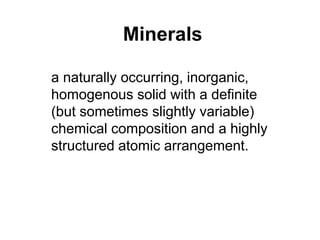
Introduction to Mineralogy (The Basics of Earth Science)
- 1. Minerals a naturally occurring, inorganic, homogenous solid with a definite (but sometimes slightly variable) chemical composition and a highly structured atomic arrangement.
- 2. naturally occurring: will distinguish between those materials that are synthetically produced in a laboratory and those that are created by natural processes.
- 3. All minerals are produced from various processes that are independent of living organisms and thus are inorganic.
- 4. Homogenous solid: refers to the mineral’s consistency throughout its mass and is neither liquid nor gas. Meaning that the mineral cannot be further subdivided into mineralogical components.
- 5. Chemical Composition: minerals can have alternative element constituents as part of its chemical formula. Generally, these variations are slight and the mineral is able to maintain its identity.
- 6. Highly structured atomic arrangement: This indicates that there is an ordered framework of atoms building the mineral.
- 7. Physical Properties • Mechanical Properties Hardness The hardness of a mineral is its resistance to scratching or abrasion. Every mineral can be tested for its hardness by either Moh’s Hardness Scale or by a relative hardness scale. Moh’s Hardness Scale • 1 talc 6 felspar • 2 gypsum 7 quartz • 3 calcite 8 topaz • 4 flourite 9 corundum • 5 apatite 10 diamond
- 8. There is also a relative hardness scale that can be used in conjunction with the above scale. The items on this scale are common objects that can be used in testing the minerals. fingernail 2.2 glass plate 5.5 new penny 3.2 streak plate 7 steel nail 5
- 9. Talc Talc is the softest mineral on the Mohs scale. This softness makes it very useful. Soapstone is made mainly of talc and is often carved into decorative shapes. Corundum Corundum is better known by other names-blue corundum is called sapphire, red corundum is called ruby. Second only to diamonds in hardness, corundum is made into valuable jewelry and tools like emery boards. It can scratch every mineral but diamond.
- 10. The cleavage of a mineral is its tendency to break along weakened planes within the mineral. These areas of weakness are a result of weak chemical bonding within the atomic arrangement of the crystal. Cleavage
- 11. Cleavage:
- 12. Cleavage Directions Angle Mineral Examples • basal 1 - micas, graphite • prismatic 2 ~60 or ~90 pyroxene, amphibole • rhombohedral 3 not 90 calcite, dolomite • cubic 3 90 halite, galena • octahedral 4 ~70 flourite • dodecahedral 6 60 sphalerite
- 13. Fracture If a mineral does not exhibit cleavage of any type, then the mineral is said to fracture. The fracture of a mineral refers to its breakage in numerous random directions without any 3 repetition of a set pattern. Fracture will occur in a mineral due to the internal chemical bonding being fairly uniform throughout the mineral’s mass. There are several terms for fracture which include conchoidal, hackly, and irregular.
- 15. Optical Properties These properties are defined by the way light interacts with the surface of the mineral. These interactions include absorption, refraction, reflection, and transmission of light.
- 16. Color The color of a mineral is not its most reliable characteristic. In many instances, the color of a mineral may vary greatly. Impurities of trace amounts of other elements present in the mineral may cause the differential coloration. For example, amethyst is merely quartz with trace amounts of ferric iron.
- 17. Streak • The streak of a mineral is a much more reliable test than the color of a mineral. The streak of a mineral is the representation of that mineral in its powdered form. This test allows several of the chemical bonds to be broken.
- 18. Luster • Luster is the way in which a mineral reflects light. The two major divisions of luster are metallic and nonmetallic. If a mineral has a metallic luster, then most of the light that “hits” the mineral is reflected back and is considered to be opaque. Nonmetallic minerals interact with the light differently by displacing a range of reflectivities and are considered to be translucent to transparent.
- 19. Luster • There are several terms used to describe nonmetallic luster. They pertain to the amount of reflectivity that is displayed by the sample. Some of the terms include adamantine, resinous,vitreous, pearly, silky, greasy, and earthy.
- 20. Taste • Taste is only testable on those minerals that are water-soluble. Tasting of every mineral sample is not recommended as some minerals contain arsenic and mercury and are poisonous. To taste a mineral, simply wet the end of your finger, rub the finger on the sample, and place the finger to your tongue.
- 21. Magnetism Magnetism is a fundamental property in some minerals that occurs due to unpaired electrons on certain atoms. Magnetite, pyrrhotite, and some samples of hematite, are attracted by a small magnet.
- 22. Solubility in Acid Some minerals will react with acid. The most common use for acid is using dilute hydrochloric acid on members of the carbonate mineral group. Other minerals will react with other acids and with acids at various temperatures.